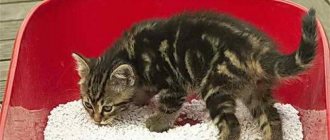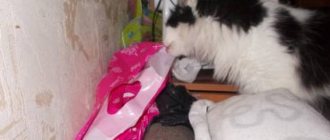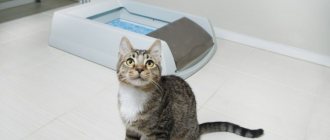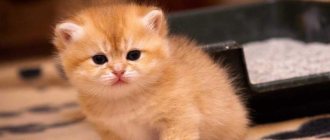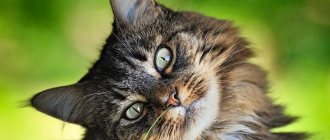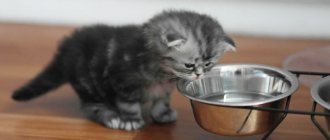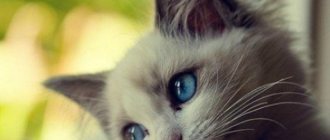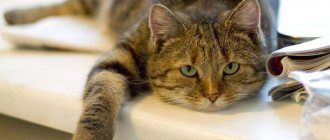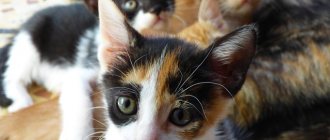What kind of water should you give your cat?
If the reason why the cat does not drink water is the quality of the water, then this problem can be easily solved. It is enough to go to the pet store and buy special water for animals: Purivitin Aqua, BIOlight, etc. It contains all the necessary vitamins and minerals for the normal functioning of a cat. However, you shouldn’t abuse it either, but give it to your pet as prescribed by the doctor.
Cats often develop the habit of drinking tap water.
If all the conditions are met, then the cat will sooner or later start drinking water. It is better, of course, if it happens as soon as possible, since a lack of water can lead to dehydration of the animal’s body. Therefore, you should monitor your cat’s fluid intake. However, if no other alarming symptoms are noticed in the animal, then you should not immediately panic. As a last resort, you can feed your pet with a syringe, placing it in the corner of the mouth. Don't forget to praise him every time.
Some people think that if they give their pet wet food, then the liquid it contains will be enough for him. However, it is not. For 1 kg of animal weight there are 20-40 ml of water. If you calculate how many sachets a cat consumes daily, it is obvious that she does not take in the required amount of fluid.
20-40 ml of water per 1 kg of animal weight
There is also an opinion that cats are divided into 2 types: water drinkers and light drinkers. But it is also wrong, because animals of the same age need the same amount of water, and the older they get, the less their need decreases. Therefore, starting from the age of five, owners should carefully monitor the amount of fluid their pet consumes.
To understand whether your cat has enough water or not, you can conduct a kind of test, which consists of the following: grab it by the scruff of the neck and let it go. If its skin quickly smoothes out, then everything is fine. If it puffs up for some time and then slowly straightens out, it means that it has health problems, perhaps this is due to the occurrence of urolithiasis.
When feeding your cat dry food, she should be given more water.
Cats love running water
You place a bowl full of fresh water in front of your cat, but it remains untouched. But as soon as you open the tap, the cat is right there to lap up the falling drops. There are several reasons why a cat may not want to touch still water. Instinctively, your cat may be suspicious of standing water because ancestral experience tells her that standing water is not always safe and can be contaminated. Running water is safer.
Another reason is the hunched position over the bowl, which makes the cat very vulnerable. Especially if the bowl is in a corner, so the cat is forced to sit with its back to other cats who might jump on it.
Also, dripping water from a faucet or running water in a cat fountain may taste better because it is cool and oxygenated. Plus, the movement of the water makes it more attractive. You probably noticed this when watching a cat play with a trickle of water with its paws.
Why doesn't the cat drink water?
It’s not so scary if the cat drinks little water.
In addition, many breeds generally come from desert areas, and in the desert, as you know, there is practically no water. Normal physiological water consumption is considered if a cat weighing up to about four kilograms drinks half a regular glass of liquid. Water is necessary for the body for the normal functioning of all body systems.
Is it harmful?
It is also part of every single cell of the animal’s body. Thus, we can conclude that a cat simply needs water, and dehydration is fraught with many serious problems. Most pets who drink little suffer from urolithiasis. If at the same time the diet of such an animal is not properly balanced, then stones in the bladder or kidneys are guaranteed.
The cat needs water!
There are a number of negative consequences that result from minimally hydrating food:
- as a result of dehydration, the inability to form urea;
- the minimal amount of remaining urine becomes highly concentrated and becomes toxic;
- precipitation of salts;
- formation of stones from precipitation.
When cleaning the cat's litter box, yellowish crusts are observed on the bottom, which are very difficult to wash off. This is nothing more than salt deposits and the same ones are found in the renal pelvis. To avoid this, the animal simply needs to drink enough fluid.
What are the dangers of not drinking water?
Cats are principled animals. If the bowl doesn't smell right or is in the wrong place, the cat won't drink from it. This can last quite a long time and lead to the development of dangerous consequences.
Due to their structural features, cats are prone to the formation of kidney stones and disruption of the functioning of this organ. This is due to stagnation of urine. If a cat does not drink for a long time, he does not go to the toilet. Residual urine is always present in the bladder, but in the absence of regular urination it stagnates. Due to thickening and stagnation of urine, a specific sediment containing salts falls. These salts accumulate and over time, kidney stones (stones) form. Kidney dysfunction can be detected by examining the cat's litter box. As a rule, salts settle on the plastic of the tray and form sand.
Over time, stones can cause serious abnormalities in the functioning of the urinary system and even lead to the development of kidney failure. Thus, the cat should drink to prevent urolithiasis.
Dehydration of the animal's body is indicated by a violation of the elasticity of the skin. It’s easy to check – you just need to pull back the skin on the back of your furry pet’s neck. If it quickly returns to its original state, then there is no cause for concern. Water deficiency is evidenced by the inability to retract the skin and a long return to its original state after such manipulation.
Related publications:
What causes a cat to shed a lot?
A cat was bitten by a tick: how to help your pet?
What to do when a cat has pain near its tail?
How to protect a cat from toxoplasmosis: ways of infection...
Why do cats refuse water?
Each cat is individual, and refusal to accept water may be due to the animal's habits or personal preferences. Among them:
- Poor quality drinking bowl material;
- Stale water;
- Incorrect placement of the water bowl.
Plastic and stainless steel affect the taste of water. A cat may refuse water if it is in such a container. There is a solution - buy a glass or ceramic drinking bowl. Such materials do not affect the taste and smell of the liquids that are poured into them.
The cat does not drink water unless it is fresh. At the same time, the concept of freshness among furry pets is somewhat unique. Some cats will not come to the water bowl if the water has been sitting in the bowl for more than a few hours. The solution is to change the water 2-4 times a day, or pour a fresh portion immediately after feeding the cat.
Some pets will not drink water that is located next to their food bowl. This behavior is determined by instincts, since in the wild a cat never drinks where it has caught and eaten prey. In general, a cat may have its own idea of the ideal location of the drinking bowl, and the owner will have to guess her preferences. To do this, it is recommended to place containers of water in different rooms and watch your pet. If the animal comes up to drink from a bowl, fresh water should always be left in this place. Interestingly, some animals prefer only running water. There are two options here - either purchase a special fountain, or do not completely close the tap.
How to stop a cat from drinking from the tap?
To wean a cat, you should use several quite effective methods:
- it is advisable not to place both bowls next to each other: one should be located at a distance from the other in order to exclude the manifestation of the pet’s animal instincts, its genetic memory of hunting in the wild;
- you can install several bowls of drinking water in different rooms so that the cat does not forget about the need to quench its thirst;
- it is optimal to purchase a transparent container for drinking so that the animal can see that there is drinking liquid there (ceramic containers are a good option);
- in hot weather, put a couple of pieces of ice in a bowl to keep the water cool;
- automatic waterer if you have several four-legged purring friends in your house;
- an alternative could be a small water fountain.
In any case, moisture for representatives of the cat family must be clean and free of bacteria and other harmful microorganisms. Otherwise, their health will be seriously compromised. If your cat drinks from the tap, try to wean him off using the above methods.
Cleaning methods
The easiest way to purify tap water is to filter it. You can install a stationary filter through which water will flow for drinking and cooking, and from a regular tap for technical needs. A cheaper option are filter jugs.
In addition to filtering, there are several other cleaning methods:
- It is recommended to let the water sit for at least 7-10 hours before boiling it, this will help get rid of small debris and chlorine;
- when freezing, clean water freezes first; if after some time you drain the unfrozen liquid, the ice can be defrosted and used for drinking;
- activated carbon absorbs many contaminants, so you can put 3-4 tablets into the container;
- leaving a vessel with water in which an object made of natural silver is placed overnight will help disinfect it.
How to make a cat drink water
You can’t convince a cat with words: he will pretend that he doesn’t understand this human thing of yours. We'll have to guess what doesn't suit him.
Try experimenting with the location of the bowl in your apartment, its color and size. If that doesn't work, try adding chicken broth to the water. The smell of meat will attract the cat.
Add an element of play to your drinking by placing a toy or ice cube in the bowl. The cat will want to get the object and will start lapping up the water.
Give your cat a water ceremony: pour some water into different containers and see how the cat reacts to it. He may be tempted to try the liquid.
If all else fails, you will have to inject water using a syringe without a needle. Do it as a game and do not use force. The cat should not begin to be afraid of water: our goal was to instill a love for it. Pour in carefully and do not let the cat choke.
Even the most harmful cats eventually start drinking water: where can one go from it? Be patient with your pet's antics.
How to wean your pet off tap water?
Often the pet stops doing this after purchasing a drinking fountain.
There are some tips:
- First, try changing the bowl your cat drinks from. Choose the most convenient size and material. Pour different levels of liquid and see how comfortable your pet is.
- Add a couple of ice cubes to the water and change it often, do not let it stagnate.
- If the cat was previously given boiled water, replace it with filtered water. Due to the excess salt content, boiled water is no less harmful than tap water.
- If you can keep the tap on for the sake of your pet, then install a filter. Drinking from the tap shouldn't be harmful.
- Separate eating and drinking areas. A cat may be distracted by the smell it smells from its food.
- Buying a special fountain can also solve the problem. It provides constant filtration, removal of impurities and a continuous flow of water, which is so attractive to pets at the tap.
If the cat completely refuses to drink or, conversely, the amount of liquid drunk increases dramatically, it is necessary to show the pet to a veterinarian.
It is possible to stop your pet from drinking from the tap. You just need to be patient, kind and consistent in your actions. Give your cat time to change his habit. Don't scold or rush. Feed your pets correctly, please them with your care, and they will return positive emotions in much greater quantities.
What to do if your cat drinks too little or too much
If, after all the tricks, the cat drinks very little (less than 20 ml per 1 kg of weight), it makes sense to check the state of its health or switch to a different type of food, especially if there is a tendency to KSD.
If you notice that your cat has stopped drinking altogether, this is the first sign of pathology. If this is observed within 24 hours, you need to urgently contact a veterinary clinic, otherwise the cat will develop fatal dehydration. Most often, while refusing water, the cat also refuses food, and there are also some additional symptoms - lethargy, diarrhea, vomiting, and so on. When my cat got panleukopenia as a kitten, he didn't drink or eat at all for about five days. We compensated for his lack of nutrients with drips in a veterinary clinic.
If a cat drinks, on the contrary, too much, do not rush to rejoice.
Constant thirst may be a sign of kidney failure or diabetes. If the cat previously drank no more than 150 ml of water and suddenly began to drink 300-500 ml, then you just need to show it to the veterinarian.
A diet that is too low in minerals can also cause a cat to drink excessively. If there is little potassium, magnesium and other important components in the food and the same water, the cat will try to get them by drinking water. Often, if a cat really lacks minerals, she begins to chew the soil in indoor flowers or happily drinks the mineral water offered to her. In this case, it makes sense to think about changing your water and diet in general.
However, if your pet is completely healthy and you have chosen the right food for him, then he will consume the required minimum of liquid. Yes, there are healthy cats, but they drink very little, in this case you need to either experiment with food or switch the animal to a wet diet.
How can it be harmful and dangerous?
It is difficult to understand whether the water entering the apartment is safe. It depends on the region and the degree of wear of the water pipes. Most often, one glass will not pose a health hazard, but drinking raw water regularly is not recommended.
What could this mean:
- metal salts accumulate in the body and lead to the development of urolithiasis;
- if microorganisms get into the water supply, they will cause toxic infection;
- the accumulation of chlorine compounds leads to cancer.
Carefully! If a woman constantly drinks water with chlorine compounds during pregnancy, this will lead to pathologies of fetal development or miscarriage.
What to do if your cat doesn't drink water?
If you notice that your cat has stopped drinking water when everything was fine before, try to find out the reasons why she refuses it and force her to drink the liquid. How can you do this:
- If your cat receives only dry food as food, it is necessary to give it liquid, which must be poured into a water container and placed nearby. Remember, the water must always be fresh and clean, otherwise the cat will not drink it.
- Diversify her diet by adding wet canned food, as well as milk or kefir. In addition, you can cook soup or broth for her, but only without adding spices and salt.
- You can add some canned food to the liquid. The animal will immediately feel the familiar and favorite smell and want to lap it up.
- If there are no problems with the genitourinary system, you can feed your pet something salty, for example, a piece of fish. This will make him thirsty and he will look for a source of drink.
- As you have probably already noticed, cats are creatures that love to drink not from specially designed containers, but from any that come their way. You can leave water, for example, in a bucket or sink, and she will definitely drink.
The water must always be fresh and clean, otherwise the cat will not drink it.
You can water your cat using a syringe, especially if the doctor discovers diseases of the urinary system, the treatment of which requires drinking plenty of water. You will have to force water, since the animal may resist and not give in, but it still needs to be done.
Why do cats drink from the tap?
There are several versions that explain the habit of purrs drinking not from their dishes, but from plumbing equipment.
- Instincts and genetic memory. Wild cats are predators. The animals do this in order not to pollute the life-giving source with the decomposition products of the killed victims of their hunt. At home, owners most often place their bowls next to food. It is because of genetic memory that furry pets try to drink liquids away from the location of food.
- Some biologists and livestock breeders believe that the reason for the desire is the lower content of pathogenic microscopic organisms in running water. This version concerns animals that are released on the street, where they try not to quench their thirst from puddles, streams and ponds.
- Another version lies in the peculiarities of psychology, as well as in the habits of domesticated predators. Some cats perceive water jets as an imitation of the movement of small rodents. They approach the plumbing not so much to get drunk, but to play with the stream. In this way, the animals train their hunting skills.
- Most breeders of mustachioed meowing friends are inclined to believe that tap water is simply cleaner and tastier than stagnant drinking liquid. In the house, dust and grease residues from food constantly fall onto the water surface, which will lead to its contamination.
- Finally, another version is simple curiosity. Purrs are extremely curious animals, and they can drink both tap liquid and liquid from their own bowl.
Taking a bath
There are plenty of reasons why a cat drinks from a faucet, but does it harm the cat’s body?
What water to give your cat and what dishes to choose
It is important that your cat has access to clean water around the clock. Make sure the water bowl is full
Water quality is also very important. Moreover, this point is important not only for the health of the animal, but also for the formation of the habit of drinking water.
Most cats will not drink low-quality dirty water.
- Never give your animal water from the tap. Such water contains many impurities and salts, which can lead to urolithiasis. Tap water is technical for both humans and pets.
- It’s difficult to give any advice to outdoor pets, since they inevitably drink from puddles and other unclean places, but let cats drink good water at home.
- I also don’t recommend boiled water, and I don’t drink it myself, because it has a depleted mineral composition. However, there is no need to go to extremes - giving a cat mineral water is also contraindicated. Such water, on the contrary, has a high content of minerals.
- The best option is bottled drinking table water. That is, the water that we buy either in bottles or order at home is artesian water. This water has an optimal mineral composition and does not contain unnecessary impurities. There is no need for your pet to use water additionally enriched with any minerals. Natural artesian water is the most suitable option.
- As a last resort, if you do not buy drinking water, you can use water passed through a filter jug or any other filter to purify the water. In such water, although most of the harmful heavy impurities will be removed.
By the way, from the financial side of the issue, one five-liter bottle is enough for one animal with an average consumption of 150 ml per day. This will cost no more than 100 rubles per month, depending on the brand of water, which is quite affordable.
As for dishes, it is better to choose a glass or ceramic bowl. In such bowls, water disappears more slowly. Choose a bowl that is not very deep, but wide, so that the animal’s whiskers do not curl up when drinking. An uncomfortable bowl can discourage your cat from drinking.
The size and shape of the bowl matters
Try feeding your cat from different containers.
Cats have very sensitive whiskers. If the bowl is too narrow, then the cat will have to experience the unpleasant sensation of touching the sides of the bowl with its whiskers while it drinks. Try a few different sizes and shapes to see which one your cat likes. Also try bowls made from different materials. Ceramic and metal bowls are much easier to keep clean, but cats often prefer wide glass bowls.
Why does a cat drink water often?
If we are talking about an old cat, then the answer is quite obvious why she often drinks water. After all, the amount of fluid in the body only decreases over the years, so there is a need to replenish your water supply. Also, you should not worry in the case of a kitten, because its body is growing, and at the same time the need for fluid is growing. However, if the daily norm is exceeded by one and a half times, then you should sound the alarm.
As cats age, they begin to drink more water.
If you notice frequent drinking of water in large quantities, you need to seek help from a specialist who will examine your pet and determine the reason why he began to drink too much liquid. Perhaps the reason lies in the occurrence of kidney failure, urolithiasis, diabetes, hormonal imbalance. Then the doctor will prescribe the necessary treatment, as well as a diet. This phenomenon is also observed with an unhealthy diet, which includes sweets or salty foods. Perhaps the cat is simply trying to quench its thirst in hot weather.
However, if at the same time you notice vomiting in the animal, then you should immediately consult a doctor. Especially if they have an unpleasant odor and drooling is noticed.
If your cat starts drinking water frequently, contact a specialist.
Cats need wet food
Canned cat food helps your cat get the moisture it needs.
Because modern domestic cats are descended from desert-dwelling ancestors, they have little thirst. Compared to dogs, cats do not have an urgent need to find water. They will not, like dogs, look for any source of moisture just to quench their thirst. Because cats do not drink enough water and have very concentrated urine, they develop problems with their urinary system. Experts recommend preventing these problems by feeding your cat wet food periodically.
In the wild, cats eat prey such as mice, which are 70% water. Most wet food has a minimum of 75% moisture, while dry food has only 10% moisture. Therefore, wet food has two useful functions at once - it gives the cat the necessary nutrients and maintains fluid levels in the body.
Cats fed wet food also have a lower risk of developing hyperthyroidism, diabetes, constipation and obesity.
How can this problem be solved?
First we need to discuss water quality. Cats will always prefer fresh, clean water to stagnant or cloudy water. Therefore, the water should be changed daily or even several times a day - it will only be better.
If a dog lives in the house with a cat, then it will probably drink from the same bowl, which can also affect the cat’s attitude towards such water. In this case, you should block the dog's access to the cat's drinking bowl. For example, a bowl can be placed on a windowsill.
One of the unsuccessful options for a water container is a double bowl into which both food and water are poured. In bowls with a similar device, food particles often fall into the water, contaminating it. The same thing happens when the water bowl is too close to the food bowl. Also, you should not use the same bowl for eating and drinking; in other words, the drinking bowl must be a separate container.
Care should be taken to ensure that the water does not contain any impurities and does not have any repulsive odors. Perhaps you should refrain from using various detergents and cleaning products, since they leave odors that the cat will not necessarily like. Although it can be argued that she will not like them for sure.
Cats don't like "old" water
Cats are very sensitive to tastes. Try to change the water in the bowl every day, otherwise it will seem musty to your cat. Pieces of food and dust can settle on the water, making it not only tasteless, but also full of various bacteria. If your cat plays with water, dirt from her paws will also get into the water (think of the cat's litter box).
Wash your cat's bowl once a day with dish soap. Be sure to rinse the bowl very well. Leftover product can taste very nasty and can also burn your cat's tongue.
Why doesn’t a kitten drink water from a bowl, how can I teach him to do this?
Accustoming a kitten weaned from its mother to drink water is the primary task of the baby’s owner. The baby refuses to lap up the water because its smell and taste seem strange to him, because they are not at all like mother’s milk. One of the following methods will help you teach your kitten to drink water:
Use a dark container for liquid that will not distract the small pet’s attention from drinking. Sprinkle a few drops onto the baby and create circles on the surface of the water. It is best to instill the baby's interest in the contents of a bowl of water in a playful way. Place a piece of cloth lightly moistened with liquid mint extract or a sprig of a fresh plant under the container with liquid. Place several bowls of water around the house, which are sure to attract the attention of a curious baby. Wet baby's nose with water
He will instinctively lick his nose, tasting the taste of the liquid.
To teach a small pet to drink water, you should not poke it with its muzzle. This can greatly frighten the baby.
Monitor the water level
Make sure that the water level in the bowl never gets too low and do not fill it to the brim. Cats are creatures of habit and they really don't like change. Don't pour a full bowl one day and only half the next. Some cats start pawing at the water because they can't see the surface of the water and aren't sure where it might be today. Cats love consistency, so try to always pour water at the same level.
Original article in English Translation by Lysikov A.

